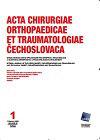全膝关节置换术周围早期透光线的发生和发展。
摘要
研究目的:全膝关节置换术(TKA)周围可能出现放射线(RL);它们在胫骨下比在股骨下更常见。RL线是TKA和骨水泥之间的间隙,或骨水泥和骨床之间的间隙。它们在手术后立即清晰可见,也可能稍后出现。它们构成了界面的病理学,主要是由于它们与无菌性松动的潜在关联而受到研究。本研究的目的是评估在日常临床实践中,它们在术后第一次x线片上清晰可见的频率,在接下来的两年里它们是如何发展的,并将结果与现有的专业文献进行比较。另一个目的是评估RL线与组件对齐、患者习惯和手术临床结果之间的关系。材料与方法本组纳入62例患者,共植入69枚TKA假体,其中男性28例(45.2%),女性34例(54.8%),年龄46 ~ 79岁。在术后第一次x线片上监测RL线的发生,随后在接下来的2年中每隔一年监测一次。根据Meneghini等人的概念,对RL线的位置和组件的放置进行放射学评估。使用膝关节社会评分(KSS)评估手术效果,并使用BMI指数评估体质。采用4点满意度量表对手术结果进行主观评价。结果术后第一次x线片显示9个tka(13.0%)中9个(0.8%)位置出现RL线。术后1年的对照x线片显示29例tka中42例(3.8%)位置有RL线。在手术后2年进行的最后一次检查中,在33个tka(47.8%)的60个(5.4%)位置检测到RL线。在整个随访期间,在6个(8.7%)tka的6个位置发生了现有RL线的进展。相反,在6个(8.7%)tka中,RL线在8个位置消失。RL线的发生与术后肢体轴之间存在关联(内翻畸形的风险更高)。此外,随BMI值的增加,RL系的频率也增加。KSS、手术满意度与RL线的发生无相关性。讨论与结论RL线的出现频率与文献中描述的大致相符。有些线条显示级数,有些线条消失。到目前为止,我们还无法区分具有预测意义的RL系和不重要的RL系。毫无疑问,RL线表面的大小及其原因也很重要。在TKA术后内翻畸形中,随着BMI值的增加,RL线出现的频率更高。股骨前部下的RL线有向前发展的趋势。为了避免这些问题,我们建议改进固井技术。临床意义在于RL线的发生与手术的主观或临床结果无关。关键词:全膝关节置换术;全膝关节置换术;射线可透过的行;进展;对齐;膝关节社会评分;BMI。PURPOSE OF THE STUDY Radiolucent (RL) lines may appear around the total knee arthroplasty (TKA); they occur much more frequently under the tibial component than under the femoral one. The RL lines are gaps between the TKA and the cement, or between the cement and the bone bed. They are clearly visible immediately after the surgery or may appear later. They constitute pathology of the interface and are subject to research mainly due to their potential association with aseptic loosening. The aim of this study was to assess how often they are clearly visible on the first postoperative radiograph in everyday clinical practice, how they develop during the following two years, and to compare the results with the available professional literature. Another aim was to assess the relation between RL lines and the alignment of components, the patient's habitus and clinical outcomes of the surgery. MATERIAL AND METHODS The group included 62 patients with a total number of 69 TKA implants, of which 28 were men (45.2%) and 34 women (54.8%) aged 46 to 79 years of age. The occurrence of RL lines was monitored on the first postoperative radiograph and subsequently at a one-year interval during the following 2 years. The location of RL lines and the placement of components were assessed radiographically in terms of the concept by Meneghini et al. The evaluation of surgical outcomes was done using the Knee Society Score (KSS), and the habitus was assessed with the BMI index. Subjective evaluation of the surgical outcome was done using the 4-point satisfaction scale. RESULTS The first postoperative radiographs showed a RL line at 9 (0.8%) locations in 9 (13.0%) TKAs. The control radiographs made 1 year after the surgery showed a RL line at 42 (3.8%) locations in 29 (42.0%) TKAs. During the last check conducted 2 years after the surgery, a RL line was detected at 60 (5.4%) locations in 33 (47.8%) TKAs. Throughout the follow-up period, progression of the existing RL line occurred at 6 locations in 6 (8.7%) TKAs. On the very contrary, the RL line disappeared at 8 locations in 6 (8.7%) TKAs. An association was found between the RL line occurrence and postoperative limb axis (a higher risk was posed by the varus deformity). Moreover, the frequency of RL lines increased with the growing BMI value. No relation was found between the KSS and satisfaction with the surgery and the occurrence of RL lines. DISCUSSION AND CONCLUSIONS The occurrence of RL lines corresponds roughly with the frequency stated in literature. Some lines show progression, other disappear. So far, we have been unable to distinguish the predictively significant RL lines from the insignificant ones. Important will undoubtedly also be the size of surface of RL lines and their cause. More frequent RL lines were observed in the postoperative varus deformity of TKA and with the growing BMI value. The RL lines under the anterior part of the femoral component showed a tendency to progress. In order to avoid them we recommend modifying the cementing technique. Clinically significant is the fact that the RL lines occurrence correlates neither with subjective nor with clinical outcomes of the surgery. Key words: total knee arthroplasty; total knee replacement; radiolucent lines; progression; alignment; Knee Society Score; BMI.

 求助内容:
求助内容: 应助结果提醒方式:
应助结果提醒方式:


